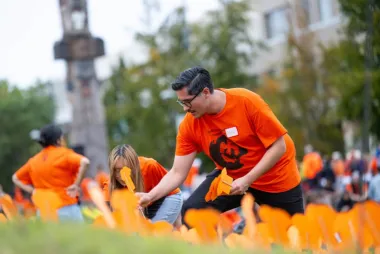It’s getting better for trans, bisexual and gay youth – but there’s still room to improve
May 17th is the International Day Against Homophobia, Biphobia and Transphobia, celebrating sexual and gender diversity – and highlighting the continued challenges faced by the 2SLGBTQIA+ community.

Edited: July 6, 2022
Q & A - Dr. Elizabeth Saewyc
In this Q&A, UBC nursing professor Dr. Elizabeth Saewyc, director of the Stigma and Resilience Among Vulnerable Youth Centre (SARAVYC), shares how we can better support the health of trans, bisexual and gay youth in B.C.
What are the challenges that trans, bisexual and gay youth still face in B.C.?
Two Spirit, lesbian, gay, bisexual, trans, non-binary, queer and questioning (2SLGBTQ+) young people in B.C. still face higher rates of discrimination and harassment compared to their peers. They feel less supported by family, school and the community, and feel less safe at school and less connected socially. Together, higher rates of violence and lower levels of support contribute to health gaps for 2SLGBTQ+ youth.
For lesbian, gay and bisexual teens, things are getting better. In one of our recent reports, we found that the percentage of lesbian girls who reported being assaulted in school has dropped by half, and rates have also declined for bisexual girls and boys. This narrows the gap compared to their heterosexual peers, although they are still more likely to experience violence in school.
Dating violence and physical or sexual abuse have also declined – but the rates of verbal harassment and social exclusion haven’t changed much for lesbian, gay and bisexual teens in B.C. over the past decade.
We have less data about trans and non-binary youth, but SARAVYC’s 2021 report shows they too are more likely to experience discrimination, harassment and violence than cisgender young people.

How does stigma and discrimination affect the health of young people?
More than 15 years of research at SARAVYC has shown that stigma and discrimination have significant health consequences for young people’s health. Bullying and other forms of violence cause stress and harms that can have long-term impacts.
We have seen that the more types of violence and discrimination that young people experience, the greater the chance they will face mental health challenges like depression and suicidal thoughts and attempts.
For example, transgender and non-binary youth who experience more bullying and discrimination are more likely to report seriously thinking about suicide. We’ve seen similar links between violence and mental health for lesbian, gay, bisexual and queer youth. 2SLGBTQ+ youth who are also racialized (Black, Indigenous and other people of colour) may face racism and sexism in addition to homophobia, biphobia and transphobia—and these added stressors can contribute to further health challenges.
We also have found links to substance use problems, poorer reported overall health and lower safety in school, which can contribute to skipping school or avoiding sports and other extracurricular activities out of fear of bullying. These in turn can have effects on young people’s future health and school performance.

How can schools and families improve safety in schools and communities?
Our research has shown that gender-sexuality alliances, or GSAs, are an important strategy for schools and community groups. They reduce the odds of bullying, as well as health issues like suicidal thoughts and attempts, and substance use.
Safe School policies that address homophobic, biphobic and transphobic bullying in schools can also make a difference, if they are enforced. Training for school staff, like the SOGI 1 2 3 teacher supports, are another great help for creating inclusive climates in schools. And movies and theatre performances have also been shown to reduce homophobic attitudes among students and improve school safety. That in turn leads to better emotional health among 2SLGBTQ+ youth in schools.
Other strategies that can help make a difference are community events that demonstrate inclusion and celebrate diversity, such rainbow sidewalks and pride events. These are linked to greater sense of safety and community belonging and lower rates of substance use and suicide.
Finally, we need to support parents with information and guidance so they can better support their 2SLGBTQ+ young people. We know that parent acceptance and family support overall makes a huge difference in young people’s well-being for nearly all young people, and 2SLGBTQ+ youth also need that family support to thrive.
Learn More
Read Not Yet Equal, the full report on findings from the B.C. National Adolescent Health Survey.
Explore more publications from the Stigma and Resilience Among Vulnerable Youth Centre (SARAVYC).


